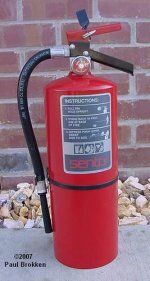Bigfoot62
Veteran Member
- Joined
- Aug 5, 2008
- Messages
- 2,478
- Location
- W. Central Louisiana
- Tractor
- JD 5090M; JD 5085M; JD 5083E; NH TN70A; Ford 2600
Instead of tossing them, take them with you to the fire extinguisher company. Actually, a few of the older F.A. brand extinguishers were made by Ansul and are a quality product. It should cost less to hydro and recharge them than replace. The Ansuls that I'm talking about will be 5 or 10 pound capactiy with steel cylinders and bright aluminum, square-shaped valves.Good thread! I guess I will pitch my 18 year old First Alert extinguishers and give the local fire extinguisher company a call.
Here's a pic of a 10# Ansul Sentry. The First Alert will look just like it except for the name on the label:
http://farm2.staticflickr.com/1007/1449584973_66341591bc.jpg
 The 5# will look the same, but have bright aluminum handles, and be a bit smaller.
The 5# will look the same, but have bright aluminum handles, and be a bit smaller.However, if the extinguisher has a plastic valve and aluminum cylinder, it's trash.
A word of caution:
Before disposing of any fire extinguisher, be sure to operate the valve and discharge the contents. Make sure that all the pressure is relieved. If possible, once it's completely empty, unscrew the valve assembly and remove it. The garbage truck driver will appreciate that.
![PC110004 [].JPG](/forums/data/attachments/257/257010-bd991435c9062ee00e8db698cddf01d5.jpg)
